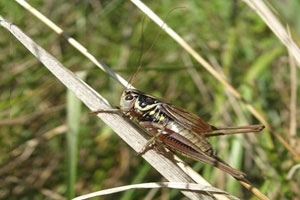Roesel’s bush-cricket (Metrioptera roeseli)
 August Johann Rosel von Rosenhof – who is he? Well, he was a well-respected German entomologist who had a cricket named after him – the Roesel’s bush-cricket.
August Johann Rosel von Rosenhof – who is he? Well, he was a well-respected German entomologist who had a cricket named after him – the Roesel’s bush-cricket.
The month of August is a really good time to look for grasshoppers and crickets as their various rasping calls can be heard throughout the month. The sound they make is produced through stridulation – a mechanism whereby one part of the body called the file is rubbed over another part called the scraper – similar to a comb passing over the edge of a piece of card. Grasshoppers use their back legs to stridulate, but crickets rub their wings together to produce their sound. The “ears” that are used to hear others are not situated in the usual place but are found in the front legs of crickets and at the base of the abdomen in grasshoppers.
Both crickets and grasshoppers are from the same family (Orthoptera), but there are differences between them. Crickets are often larger and usually nocturnal, using their “song” to communicate with others, whereas grasshoppers are diurnal and combine song and the use of sight to locate others, often climbing up vegetation for a better view of the surroundings.
The Roesel’s bush cricket, along with another cricket called the long-winged conehead, are two particularly interesting species as they are being closely watched by those who are monitoring climate change. The long-winged conehead was first recorded on the Isle of Wight in 1931 and had only extended its range to a few southern coastal counties by the end of the 1980s. Similarly the Roesel’s was only found in the Thames and Solent estuaries around this time. However, since the 1990s both species have rapidly expanded their ranges northwards and can now be found in the north Midlands. What is truly fascinating about both these species is that during particularly hot summers they are able to produce individuals with extra long wings, enabling them to travel further distances, speeding up their northerly migration.
The Roesel’s bush cricket is one of the easier species to find as their song, which is usually produced when the weather is hot and calm, has been described as sounding similar to “standing under an electricity pylon in the rain!”
Peter Thompson
Advisory

Download Peter Thompson's essential 26-page book, featuring beautiful photography and detailed profiles of Britain's wildlife
Download FREE >